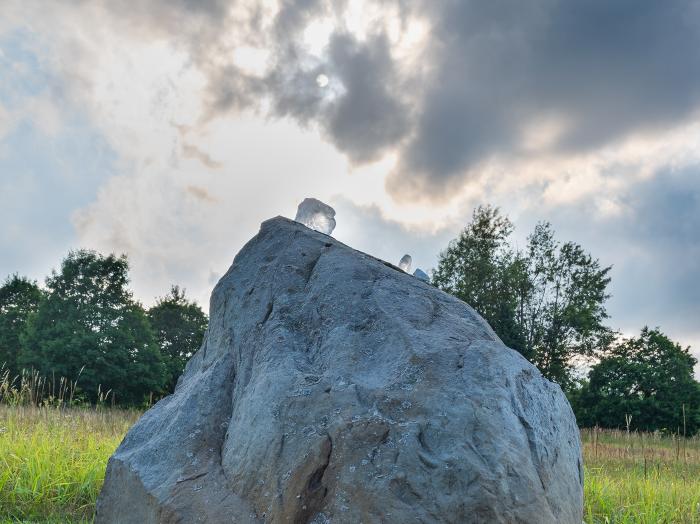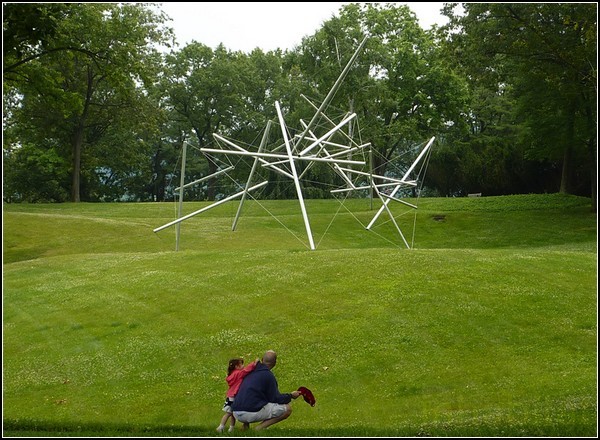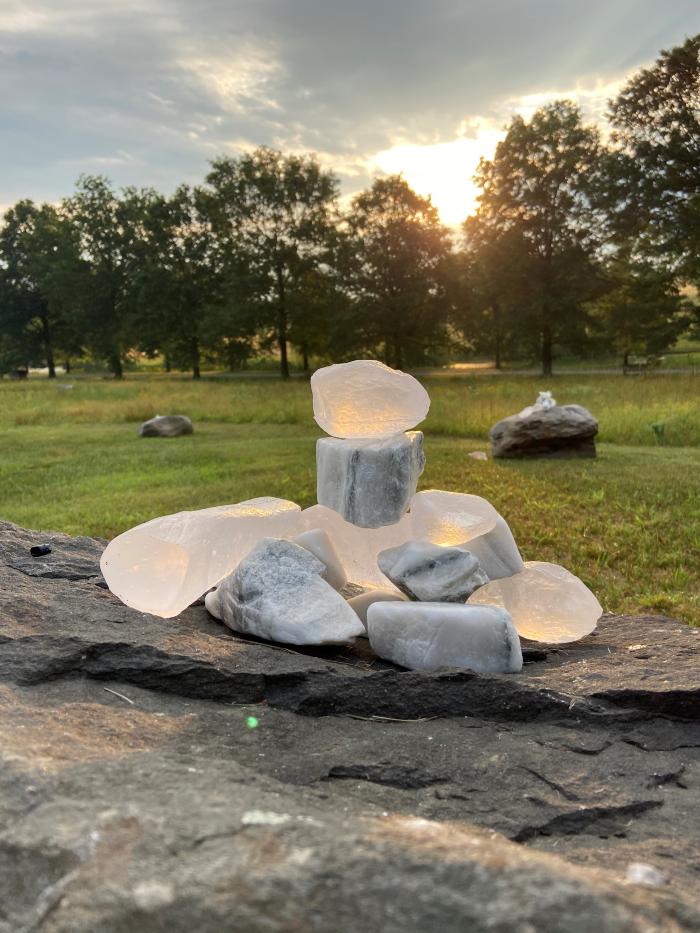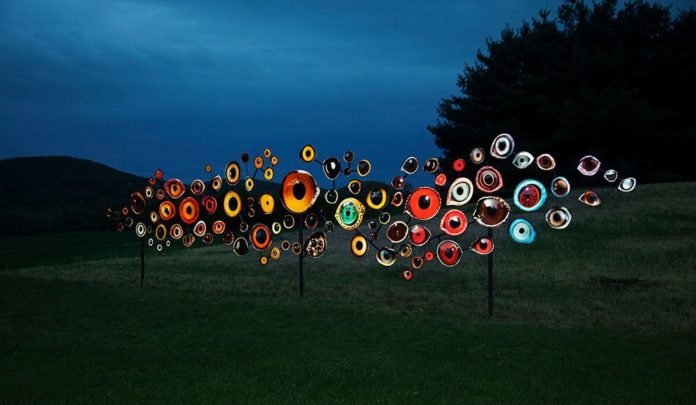Sculpture Park in upstate New York, the Storm King Art Center, is one of the most idyllic spots in the country with large-scale outdoor sculptures. There really aren’t many other places, especially in the United States, where you can see works of art of this magnitude and this kind of ambition.
Founded in 1960, the Storm King Center for the Arts in New Windsor, NY, was originally intended to illuminate visual arts and music, with a focus on the Hudson River School of Landscape Painting.
According to Lawrence, founder Ted Ogden got inspired by visiting the studio of the late artist David Smith in the Adirondack Mountains, where he saw 80 of Smith’s large-scale works displayed outdoors in the hills, as Smith himself placed during his lifetime.

This experience led Ogden to realize that he could match the beautiful landscape of the area with works of art. The art space currently boasts many ongoing artist commissions, such as The Storm King’s Wavefield by Maya Lin (2007–09) and The Schunnemünck Fork by Richard Serra (1990–91), as well as works provided, complemented by alternating temporary exhibitions.
One such exhibition earlier this year was the Light of the Kiki Smith River, which features a New York-based artist’s work of nine flags set in a circle on the Storm King Museum Hill against the backdrop of the region’s mountains and hills.
Smith began working on the project in 2005, capturing and capturing the glare of light on her daily walks along the East River in New York. “This is an installation that is completely connected to nature, which actually creates it,” explained Lawrence, noting how the flags of the piece interact with the wind and other elements.
As part of an ongoing support program for emerging artists called Perspectives, Storm King recently brought in New York artist Martha Tuttle to set up a large-scale temporary open-air project called Enceladus Rock on the site.
The work, which was unveiled before December 13, is a series of artificial stone stacks built from boulders gathered around the Storm King, as well as glass and marble copies of stones that Tuttle also collected.
Landscape sculptures at the Storm King Art Center

At the Storm King Art Center, hundreds of sculptures are scattered across 500 acres. The unusual park Storm King Art Center is also a museum of modern art, located in the town of Mountainville in the Hudson River Valley, a couple of tens of kilometers from New York.
Here, on an area of about two square kilometers (500 acres), there are more than a hundred sculptures created by authors of the second half of the twentieth century and the beginning of the twenty-first century. These sculptures are installed on the ground so as to be part of the landscape.

These sculptures are installed on the ground so as to be part of the landscape. So this park should not be visited by those who like to quickly run through the museum, taking several tens of seconds to the main objects exhibited there.
Sculpture Park Storm King Art Center was founded in the suburbs of New York, in 1960. The park’s collection includes more than a hundred sculptures, including works by Alexander Calder, David Smith, Mark di Suvero, Henry Moore, Richard Serra, Louise Nevelson, Isamu Noguchi, created in the second half of the 20th and early 21st centuries.
The sculptures on display are made of various materials: bronze, wood, plastic, and even earth. In addition to the permanent exhibition, the territory hosts temporary exhibitions organized by museums and private galleries.
Patrons make a big contribution to the existence of the Storm King Art Center.
It is charitable contributions that allow ensuring the proper level of life of the sculpture park: the safety of works of art, the neatness of the territory, as well as the holding of various educational programs in the park.
Thanks to the support of patrons and the impressive area of the park, which is 500 acres, Storm King Art Center continues to grow and develop.
The Storm King Arts Center spent the next 40 years developing a philosophy of integrating art and nature.

In the Storm King Art Center, you need to calmly and measuredly walk along the paths, looking at the sculptures and the landscapes surrounding them.
SPREADING OVER 500 ACRES, the Storm King Arts Center is hardly a sculpture garden. As his 100 installations interact with and even change territory, Storm King is more accurately described as a sculptural landscape.
In 1960, Ralph E. Ogden opened a small museum for local artists an hour north of Manhattan. A few years later, the picturesque environment around the museum began to transform. It quickly attracted sculptures and installations by a number of famous artists, including Roy Lichtenstein and Isamu Noguchi.
As steam was created for creativity, the Storm King Arts Center began to receive more donations from art, as well as some installations made specifically for the center. As the living museum expanded to 500 acres, the park took on a new lease of life, weaving into the hilly landscape.
The Storm King Arts Center spent the next 40 years developing a philosophy of integrating art and nature. There is no work that better reflects the philosophy and style of art in The King of the Storm than The Field of Waves by Maya Lin. It is a massive site-specific installation consist of seven giant man-made hills that appear to be moving.
Giving the terrain a dynamic illusion of movement, the Wavefield is not only in the territory but also in its part, swaying in the wind and in stark contrast to the hills and forests around the King of Storms. Although the Storm King is dominated by large installations, the museum itself houses nine galleries and a wide variety of works.
In keeping with the idea of improving and merging with the landscape, the museum is extremely aesthetic and is located inside an 85-year-old castle. Visitors are invited to stroll around the grounds while interacting with art and landscape.
Storm King complements its permanent exhibition with special exhibitions and installations. These can be large-scale sculptures housed in open galleries defined by the sky and landscape, or smaller pieces and supporting materials displayed in the Storm King Museum building.
Exhibitions include loans from artists, private collectors, galleries, and museums, as well as works from the permanent collection. Click here to view upcoming or ongoing exhibitions.
OUTLOOKS: MARTHA TUTTLE

For the eighth year of its Outlooks Art Center program, Storm King invites aspiring middle-aged artists to present a large-scale temporary outdoor landscape project, Storm King introduces New York-based artist Martha Tuttle.
The Stone Thinking of Enceladus refers to the historical practice of mapping as well as finding meaning in the landscape, both emotionally and physically. The work includes a series of faux stone stacks or cairns built from boulders collected in Storm King, as well as molded glass and carved marble stones that the artist hand-crafted in the winter and spring of 2020.
Tuttle placed about 200 handmade glass and marble stones on large boulders in and around Storm King’s property. Through these carefully placed groups, the artist invites viewers to become aware of their physical identity both on land and within it – particularly in Storm King and the Hudson Valley – by creating a point of contact between human and non-human energy.
The poetic title of the work is based on the artist’s reflections on the scale. The glass stones in the sculpture reflect light. It is not unlike Enceladus, the icy moon of Saturn, and the most reflective object in our solar system.
Tuttle’s project, which spans eight acres of a large hilly field in the southern part of the Storm King’s domain, builds on the artist’s ongoing interest in our relationship to materiality, interacting directly with the Storm King’s landscape to further explore the unification of the natural world. shapes with the energy and touch of a human hand.
An accompanying sign next to the sculpture depicts written reflections on the scale, location, and geological extent of the Hudson Valley. Tuttle’s work appears on the Internet as a special feature and is accompanied by a series of virtual programs of meditations, readings, poems, and performances inspired by Tuttle’s installation in Storm King Museum.
New York City vocalist Charmaine Lee wrote The Stone Expands It in response to Tuttle’s The Stone That Thinks of Enceladus for the public show Back to the Field hosted by Tuttle and poet Gabe Cruis. The album debuted during a virtual program on September 2, 2020, on Zoom.

























